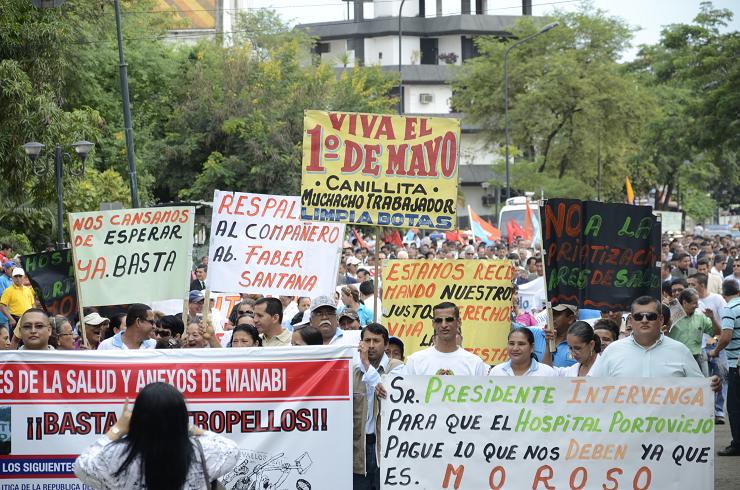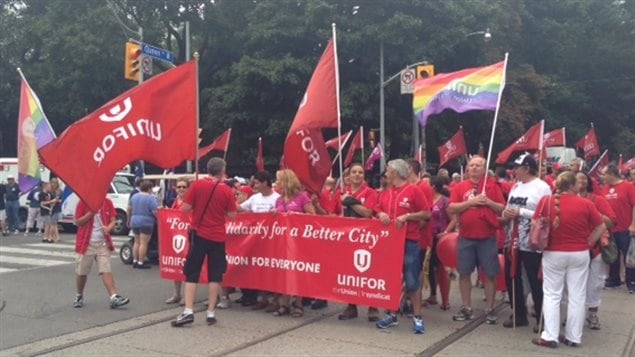ORIGIN
The first nuclei of working class in Ecuador appear only in the late nineteenth century and early twentieth. But their precarious situation reminded the workers of the central capitalist countries. And in Ecuador they began the struggle for better wages, reducing hours and conquer minimum labor rights.
To mark the centenary of the First Cry of Independence, August 10, 1909 the First Congress was held Ecuadorian Workers. In 1911, at the initiative of the Association of Suppliers Market Guayaquil, it was commemorated for the first time on 1. May, the Ecuadorian workers continued remembering in the following years. The government of Leonidas Plaza Gutiérrez, by decree of April 23, 1915, consecrated "May Day each year holiday for the workers of Ecuador". The following year (1916) was decreed in the country the 8-hour day, but was systematically circumvented. There were protests, strikes and demands of the Ecuadorian working class not only to advance the conquest of their rights, but also to achieve respect and generalization of the 8-hour day. In Guayaquil, the workers' strike called for these purposes was suppressed on 15 November 1922 with a shocking massacre of workers.
Recognizing that trajectory of struggles of incipient Ecuadorian proletariat, the July Revolution of 1925, as well as modernizing the State, institutionalized care for the working classes by creating the Ministry of Social Welfare and Labour, the dePensiones Box, issuing the first laws labor and even the introduction of income tax, which were excluded classes asalariadas.Tras those early efforts, in 1938 the new Labour Code, which recognized the fundamental principles of protecting workers and their basic guarantees was issued rights.
In later decades new institutions for the protection and rights joined the working classes of Ecuador. He grew the idea that economic development would never be enough without creating welfare conditions for the national majority.
However, the resistance of concentrators kinds of economic power failed to reverse the historical legacy of marginalization, poverty, misery, unemployment, underemployment, the plight of the employed and the scandalous concentration of wealth in minority dominant.


TRADITIONS AND ACTIVITIES
In Ecuador as with many other countries, political movements and workers made peaceful marches on May carrying banners allusive to date.
On this date not all rest or attend marches, as many jobs can not be suspended for being vital to the functioning of society, others prefer not rest as sustenance earn it every day a day without work affect their fragile economy, something very common in poor countries called third world.


LABOR DAY IN CANADA
Labor Day in Canada is celebrated on the first Monday in September in Canada since 1880. The origins of Labor Day in Canada dates back to April 14, 1872 when the parade was organized in support of the Toronto Typographical Union strike for a job 58 hours per week.
The Toronto Trades Assembly (TTA) called its 27 unions to demonstrate in support of the Typographical Union who had been on strike since March 25. George Brown, Canadian politician and editor of the Toronto Globe hit back at his striking employees, pressing the police in charge of the Typographical Union of "conspiracy. "Although the laws criminalizing union activity were outdated and had already been abolished in Britain, they were still on the books in Canada and police arrested 24 leaders of the Typographical Union.
Labour leaders I decided to call another similar demonstration on September 3 to protest the arrests. Seven unions marched in Ottawa, prompting the promise of Canadian Prime Minister Sir John A. Macdonald to repeal the "barbarism", the anti-union laws until Parliament passed the law on trade unions on 14 June of the year next, and soon all unions were demanding work 54 hours a week.
On July 23, 1894, Canadian Prime Minister John Thompson and his government made Labor Day, to be held in September, an official holiday. In the United States, the New York parade became an annual event that year, and in 1894 was adopted by US President Grover Cleveland to compete with the International Workers' Day (May).
TRADITIONS AND ACTIVITIES
While Labour Day parades and picnics are organized by unions, many Canadians attend fireworks displays, water activities, and public art events. As the new school year usually begins immediately after Labor Day, families with school-age children take it as the last chance to travel before the end of summer.
A tradition Labor Day in Canada is Labor Day Classic, an event of the Canadian Football League, where rivals like Calgary Stampeders and the Edmonton Eskimos, Hamilton Tiger-Cats and Toronto Argonauts and Roughriders Saskatchewan and Winnipeg blue Bombers play on work Day weekend.


No hay comentarios:
Publicar un comentario